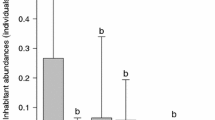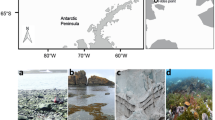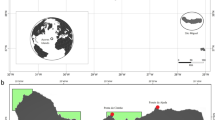Abstract
Within the Caribbean millions of queen conch (Strombus gigas Linnaeus) are harvested each year and shells discarded randomly or as middens. Fish use of discarded conch shells was investigated in four different habitat types: sand, seagrass beds, mangrove forests, and coral reefs. The study was carried out in the waters off South Caicos, Turks and Caicos Islands (TCI), between October 2003 and January 2004. The density of discarded shells was greatest near coral reefs; however, the percentage of shells occupied by adult fish was higher in isolated shells on sand and in mangrove habitats. Juvenile fish also showed a preference for sheltering in conch shells relative to other microhabitat types on sandy plains and in mangrove and seagrass habitats. Differences in use of single shells by fish in different habitats were attributed to differences in piscivore abundance and habitat complexity. Although not all isolated shells were occupied by fish, all conch middens deposited by fishermen had fish inhabitants. Examination of fish use of conch middens in three habitat types and conch piles of one, three, and five shells constructed on sand found both fish diversity and abundance increased on conch middens of increasing size. This study suggests that disposal of conch shells as large middens in habitats of low complexity will increase the amount of shelter present and may enhance fish populations in these habitats.





Similar content being viewed by others
References
Appeldoorn RS (1994) Queen conch management and research: status, needs and priorities. In: Appeldoorn RS, Rodríguez Q (eds) Queen conch biology, fisheries and mariculture. Fundación Científica Los Roques, Caracas, Venezuela, pp 301–319
Appeldoorn RS (1997) Status of queen conch fishery in the Caribbean Sea. In: Posada JM, Garcia-Moliner G (eds) Proc Int Queen Conch Conf I. Caribbean Fishery Management Council, San Juan, Puerto Rico, pp 40–59
Bene C, Tewfik A (2001) Fishing effort allocation and fishermen’s decision making process in a multi-species small-scale fishery: analysis of the conch and lobster fishery in Turks and Caicos Islands. Human Ecol 29:157–185
Beukers JJ, Jones GP (1998) Habitat complexity modifies the impact of piscivores on a coral reef fish population. Oecologia 114:50–59
Bohnsack JA, Eklund AM, Szmant AM (1997) Artificial reef research: Is there more than the attraction–production issue? Fisheries (Bethesda) 22:14–16
Boulon RH (1992) Use of mangrove prop root habitats by fish in the northern US Virgin Islands. Annu Proc Gulf Caribb Fish Inst 41:189–204
Caley MJ, St John J (1996) Refuge availability structure assemblages of tropical reef fishes. J Anim Ecol 65:414–428
Caribbean Fishery Management Council (1999) Queen conch stock assessment and management workshop. Caribbean Fishery Management Council, Belize City, Belize
Clarke RD (1994) Habitat partitioning by chaenopsid blennies in Belize and the Virgin Islands. Copeia 2:398–405
Food and Agriculture Organization of the United States (1993) Marine fishery resources of the Antilles: Lesser Antilles, Puerto Rico and Hispanola, Jamaica, Cuba. FAO Fish Tech Pap 326
Friedlander AM, Parrish JD (1998) Habitat characteristics affecting fish assemblages on a Hawaiian coral reef. J Exp Mar Biol Ecol 224:1–30
Hixon MA (1991) Predation as a process structuring coral reef fish communities. In: Sale PF (ed) The ecology of fishes on coral reefs. Academic, San Diego, pp 475–508
Humann P, DeLoach N (2002) Reef creature identification. Florida Caribbean Bahamas. New World, Jacksonville, Fla., USA
Imazu M, Asakura A (1994) Distribution, reproduction and shell utilization patterns in three species of intertidal hermit crabs on a rocky shore on the Pacific coast of Japan. J Exp Mar Biol Ecol 184:41–65
Kotrschal K (1988) Blennies and endolithic bivalves differential utilization of shelter in Adriatic Blenniidae (Pisces Teleostei). Mar Ecol 9:253–269
Kuhlmann ML (1998) Spatial and temporal patterns in the dynamics and use of pen shells (Atrina rigida) as shelters in St. Joseph Bay, Florida. Bull Mar Sci 62:157–179
Manly BF, McDonald LL, Thomas DL (1993) Resource selection by animals. Chapman and Hall, London
Mather JA (1982) Choice and competition: their effects on occupancy of shell homes by Octopus joubini. Mar Freshw Behav Physiol 8:285–293
Munday PL, Jones GP (1998) The ecological implications of small body size among coral reef fishes. Oceanogr Mar Biol Annu Rev 36:373–411
Munday PL, Jones GP, Caley MJ (1997) Habitat specialization and the distribution and abundance of coral dwelling gobies. Mar Ecol Prog Ser 152:227–239
Nagelkerken I, Kleijnen S, Klop T, van den Brand RACJ, Cocheret de la Morinière E, van der Velde G (2001) Dependence of Caribbean reef fishes on mangroves and seagrass beds as nursery habitats: a comparison of fish faunas between bays with and without mangroves/seagrass beds. Mar Ecol Prog Ser 214:225–235
Polunin NVC, Roberts CM (1993) Greater biomass and value of target coral reef fishes in two small Caribbean marine reserves. Mar Ecol Prog Ser 100:167–176
Popov D (1990) Fishing South Caicos style. Times, Providenciales, Turks and Caicos Islands Summer:25–29
Randall JE (1967) Food habits of reef fishes of the West Indies. Stud Trop Oceanogr 5:665–847
Randall JE, Allen GR, Steene RC (1990) Fishes of the Great Barrier Reef and Coral Sea. Crawford House, Bathurst, N.S.W., Australia
Rice WR (1989) Analyzing tables of statistical tests. Evolution 43:223–225
Sale PF (1991) The ecology of fishes on coral reefs. Introduction. In: Sale PF (ed) The ecology of fishes on coral reefs. Academic, San Diego, Calif., USA, pp 3–11
Shulman MJ (1984) Resource limitation and recruitment patterns on coral reef fish assemblages. J Exp Mar Biol Ecol 74:85–109
Shulman MJ (1985) Recruitment of coral reef fishes: effects of distribution of predators and shelter. Ecology 66:1056–1066
Stager JC, Chen V (1996) Fossil evidence of shell length decline in queen conch (Strombus gigas L.) at Middleton Cay, Turks and Caicos Islands, British West Indies. Caribb J Sci 32:14–20
Thresher RE (1984) Reproduction in reef fishes. TFH Publications, Neptune City, N.J., USA
Turra A, Leite FPP (2004) Shell size selection by intertidal sympatric hermit crabs. Mar Biol 145:251–258
Weinstein MP, Heck KL (1979) Ichthyofauna of seagrass meadows along the Caribbean coast of Panama and in the Gulf of Mexico: composition, structure and community ecology. Mar Biol 50:97–107
Wilson DT (2001) Patterns of replenishment of coral-reef fishes in the nearshore waters of the San Blas Archipelago, Caribbean Panama. Mar Biol 139:735–753
Wilson DT, Meekan MG (2001) Environmental influences on patterns of larval replenishment in coral reef fishes. Mar Ecol Prog Ser 222:197–208
Zar JH (1999) Biostatistical analysis. Prentice Hall, Engelwood Cliffs, N.J., USA
Acknowledgements
We are greatly appreciative of the support of E. Beltz, M. Berry, J. Lawson, C. Marks, and L. Schmidt in the field. The manuscript was improved by comments from R. Fisher and D. Wilson. We also gratefully acknowledge the key financial and field logistical support provided by The School for Field Studies (SFS) Center for Marine Resource Studies, South Caicos Island, TCI.
Author information
Authors and Affiliations
Corresponding author
Additional information
Communicated by J.P. Grassle, New Brunswick
Rights and permissions
About this article
Cite this article
Wilson, S.K., Street, S. & Sato, T. Discarded queen conch (Strombus gigas) shells as shelter sites for fish. Marine Biology 147, 179–188 (2005). https://doi.org/10.1007/s00227-005-1556-2
Received:
Accepted:
Published:
Issue Date:
DOI: https://doi.org/10.1007/s00227-005-1556-2




